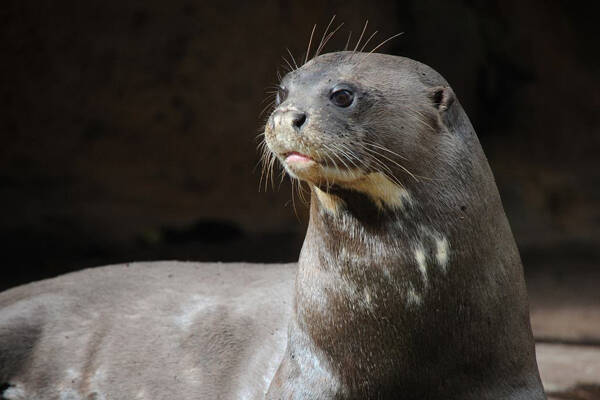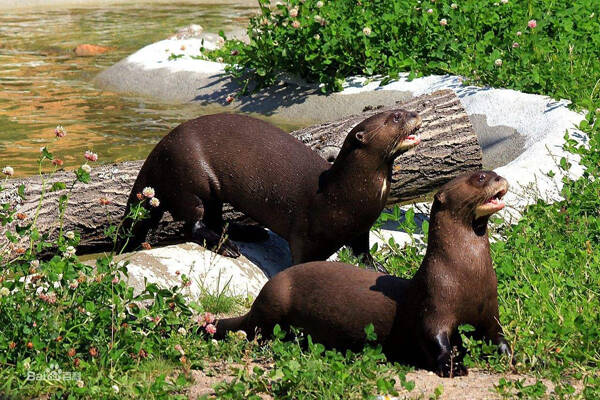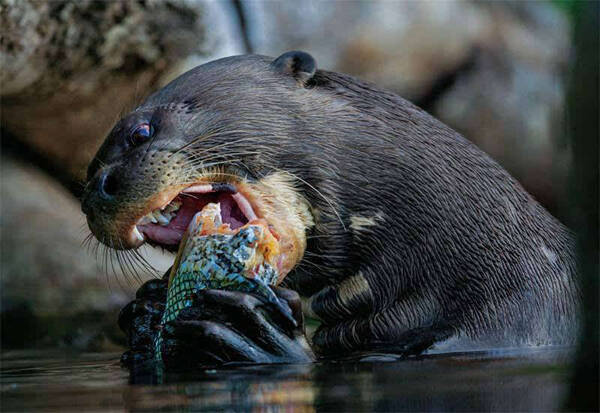Pteronura brasiliensis
IUCN
LCBasic Information
Scientific classification
- name:Pteronura brasiliensis
- Scientific Name:Pteronura brasiliensis,Giant Otter,giant otter, giant otter, South American giant otter, Brazilian giant otter
- Outline:Carnivora
- Family:Schizopoda Mustelidae Lurinae G.Otter
Vital signs
- length:1.5-1.8m
- Weight:26-32kg
- lifetime:About 10 years
Feature
It is the largest of the 13 otter species.
Distribution and Habitat
Distributed in Bolivia, Brazil, Colombia, Venezuela, Guyana, Ecuador, Peru, Suriname, Paraguay, Uruguay and the Amazon River Basin in Argentina in South America.
Only found in tropical rainforests and wetlands in South America, living near lakes and swamps. Inhabits slow-flowing rivers and streams, likes to live on steep banks, riverbanks, shallows, and rivers, lakes, streams and swamps with little aquatic plants and lush forests nearby.
Appearance
The male giant otter is 1.5-1.8 meters long and weighs 26-32 kilograms; the female is 1.5-1.7 meters long and weighs 22-26 kilograms. It is a huge, semi-aquatic mammal. Known as the "river wolf" in most of its range, the giant otter is one of the top carnivores in South America and is the largest otter in terms of total length. The giant otter has a muscular, sinuous body covered with velvety brown fur, which is dense and waterproof. The upper body is tan or chestnut brown, almost black when wet, and shiny. There is a cream-colored patch on the throat and chin, and its shape is unique to each species from birth. The lips, jaws, throat, and chest are creamy white or light yellow spots.
The giant otter is an amphibious "amphibian" and is about the size of a pug. The head is short and wide, with a slightly flat and wide front end. The eyes and ears are small, and there are small round flaps in the nostrils and ears, which can be closed when diving to prevent water i
Details
Giant Otter (scientific name: Pteronura brasiliensis) is also known as Giant Otter in English. There are 2 subspecies.

Giant otters usually move in family units during the day, usually 5-9 individuals, and rarely move alone. They usually feed on larger fish, and also prey on snakes or small crocodiles. Giant otters are masters of hunting river fish, and are particularly good at using the function of their "brains". They are very smart in combat. Giant otters are the first to use "stone tools" (unpolished gravel in the water) to knock shellfish and eat their meat! As a result, this family did not "survive by shrinking their bodies" like other animals and birds! Instead, they based their lives on "developing wisdom" and continued their lives for hundreds of millions of years.
Giant otters are social animals with super swimming ability and excellent hunting skills. They are the tyrants in the water and are called "wolves in the water". The only thing that can pose a threat to giant otters is "caimans", but they can still compete with caimans with their group strength. Once crocodiles reach the shore, they are easily attacked by giant otters. The extremely intelligent giant otters will use clever tactics to constantly tease and harass crocodiles, exhausting their physical strength, and then easily nibble on the crocodile's big tail, resulting in the phenomenon of many "bald-tailed crocodiles" in South America.
The giant otter also has several residences and often moves. The giant otter is skilled in water. Not only can it swim quickly and flexibly, but it can also close its nostrils and ears with its small round petals, and quietly swim long distances under the water. It can swim for 6-8 minutes in one breath, and then lift its nostrils out of the water to breathe. The giant otter almost hunts and lives in the water all its life. Only when it is extremely hungry will it leave the water to go to the shore to look for mice and birds, and even venture into the village to steal chickens and ducklings.

When the giant otter walks on land, its belly is close to the ground. Because of its short limbs, it is difficult to crawl, which makes it very strenuous and easy to be caught up by enemies. It has a very keen sense and a strong memory. It can land accurately from the place where it enters the water and return to the nest following the claw marks.
Giant otters breed twice a year. The estrus lasts 15-30 days. During the estrus period, female giant otters lose their appetite, look restless, scream loudly, chase each other, and bite each other's fur. The vaginal opening of female giant otters is red and swollen, and the testicles of male otters are protruding. Mating usually takes place in the water, in the early morning or evening. Before mating, male and female giant otters chase and play in the water, making "squeaks" and intermittent sharp whistles, then the female giant otter's head lies flat on the water surface, and the hindquarters sink slightly. The male giant otter quickly climbs onto the back of the female giant otter, holds her head in his mouth, and completes mating while swimming. Mating lasts 5-10 minutes. The longest time is no more than 30 minutes. When the climate is -12℃-6℃, mating can also take place on land. After 30 days of pregnancy, the female giant otter's appetite increases, the amount of exercise decreases, and the abdomen swells slightly. Before giving birth, they lie in a small room and do not come out, and they pick up grass to make a nest, and their temperament becomes fierce.

The gestation period of female giant otters is 65-70 days, and they give birth to 1-3 pups at a time. The pups are born in late August and early October. The growth and development of pups is particularly slow, and they usually open their eyes more than a month after birth. The female otter takes great care of her children during the lactation period. Except for going out to hunt, she accompanies her children almost all day long. Two months after birth, the young giant otters begin to practice swimming. The young giant otters who just entered the water seem extremely excited and agitated, but they are also very frightened. They are afraid of sinking into the water, so they hold on to their parents' tails tightly and roll over playfully. The newborn giant otter weighs about 54 grams and is 14.5 cm long. The whole body is covered with milky white or light gray hair. The eyes are closed. After 3 days, they turn into silver gray, and after 7 days, they turn into smoky gray. The eyes open at 28-31 days old. They are weaned at around 50 days old. After weaning, the young giant otters can follow the female giant otter out of the nest and crawl slowly. At 2 months old, the female giant otter often leads the young giant otter to the water's edge and lures it into the water, or carries the young giant otter into shallow water and forces it to swim. Sometimes, the young giant otter swims in the water with the young giant otter carrying the female giant otter's neck in its mouth for practice. After a week, they can swim and catch fish by themselves. After three months, they can live completely independently and live separately. The life span is more than 10 years.
The distribution range of giant otters is shrinking rapidly, and they have become extinct in Uruguay and Argentina. The traditional threat is hunting for its fur (otter fur is the "king of fur"); the current threat is the continuous development of tropical rainforests and increased immigration by humans. Deforestation causes soil erosion, reduced biodiversity, and the depletion of food sources for giant otters. Other threats include overfishing, illegal hunting, mining, and water and land pollution.
Listed in the 2016 Red List of Endangered Species of the World Conservation Union (IUCN) ver 3.1-Endangered (EN).
Protect wild animals and stop eating game.
Maintaining ecological balance is everyone's responsibility!








